
This list includes all types of constructions to lift or lower boats between two levels of a waterway, such as boat lifts, canal inclined planes, portage railways and water slopes, but excluding conventional locks.

This list includes all types of constructions to lift or lower boats between two levels of a waterway, such as boat lifts, canal inclined planes, portage railways and water slopes, but excluding conventional locks.





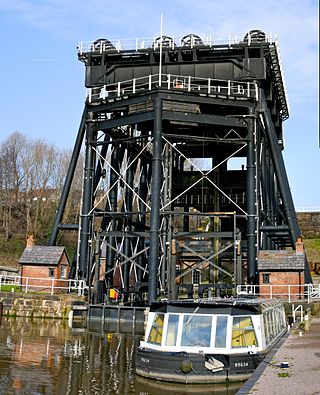
The Anderton Boat Lift is a two-caisson lift lock near the village of Anderton, Cheshire, in North West England. It provides a 50-foot (15.2 m) vertical link between two navigable waterways: the River Weaver and the Trent and Mersey Canal. The structure is designated as a scheduled monument, and is included in the National Heritage List for England; it is also known as one of the Seven Wonders of the Waterways.

An inclined plane is a type of cable railway used on some canals for raising boats between different water levels. Boats may be conveyed afloat, in caissons, or may be carried in cradles or slings.

The canals of the United Kingdom are a major part of the network of inland waterways in the United Kingdom. They have a varied history, from use for irrigation and transport, through becoming the focus of the Industrial Revolution, to today's role of recreational boating. Despite a period of abandonment, today the canal system in the United Kingdom is again increasing in use, with abandoned and derelict canals being reopened, and the construction of some new routes. Canals in England and Wales are maintained by navigation authorities. The biggest navigation authorities are the Canal & River Trust and the Environment Agency, but other canals are managed by companies, local authorities or charitable trusts.

A boat lift, ship lift, or lift lock is a machine for transporting boats between water at two different elevations, and is an alternative to the canal lock.

The Bude Canal was a canal built to serve the hilly hinterland in the Cornwall and Devon border territory in the United Kingdom, chiefly to bring lime-bearing sand for agricultural fertiliser. The Bude Canal system was one of the most unusual in Britain.

The Hay Inclined Plane is a canal inclined plane in the Ironbridge Gorge in Shropshire, with a height of 207 feet (63 m). It was located at the end of the Shropshire Canal, part of a network of canals that linked the industrial region of east Shropshire with the River Severn. The inclined plane was in operation from 1793 to 1894. It can be visited as part of the Blists Hill Victorian Town and is also a waypoint on the South Telford Heritage Trail.
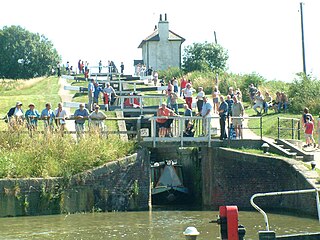
A gongoozler is a person who enjoys watching activity on the canals of the United Kingdom. The term is also used more generally to describe those who harbour an interest in canals and canal life, but do not actively participate.
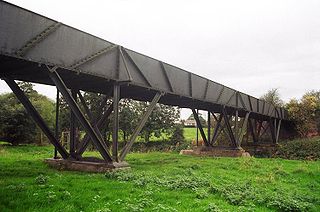
The Shrewsbury Canal was a canal in Shropshire, England. Authorised in 1793, the main line from Trench to Shrewsbury was fully open by 1797, but it remained isolated from the rest of the canal network until 1835, when the Birmingham and Liverpool Junction Canal built the Newport Branch from Norbury Junction to a new junction with the Shrewsbury Canal at Wappenshall. After ownership passed to a series of railway companies, the canal was officially abandoned in 1944; many sections have disappeared, though some bridges and other structures can still be found. There is an active campaign to preserve the remnants of the canal and to restore the Norbury to Shrewsbury line to navigation.
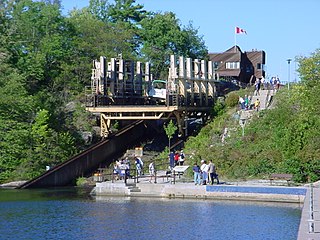
Big Chute Marine Railway is a patent slip at lock 44 of the Trent-Severn Waterway in Ontario, Canada. It works on an inclined plane to carry boats in individual cradles over a change of height of about 60 feet (18 m). It is the only marine railway of its kind in North America still in use, and is overseen by federally operated Parks Canada. This railway is vital for those cruising the 6,000-mile (9,700 km) Great Loop route.
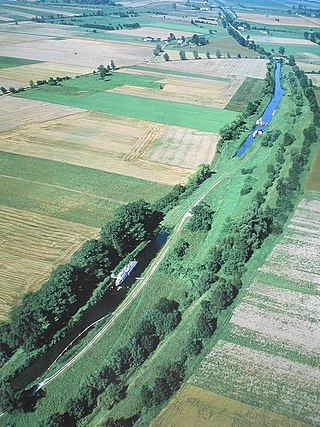
Elbląg Canal is a canal in Poland, in Warmian-Masurian Voivodeship, 80.5 kilometres (50.0 mi) in length, which runs southward from Lake Drużno, to the river Drwęca and lake Jeziorak. It can accommodate small vessels up to 50 tonnes displacement. The difference in water levels approaches 100 metres (330 ft), and is overcome using locks and a system of inclined planes between lakes.

The Strépy-Thieu boat lift lies on a branch of the Canal du Centre in the municipality of Le Rœulx, Hainaut, Belgium. With a height difference of 73.15 metres (240.0 ft) between the upstream and downstream reaches, it was the tallest boat lift in the world upon its completion, and remained so until the Three Gorges Dam ship lift in China was completed in January 2016.
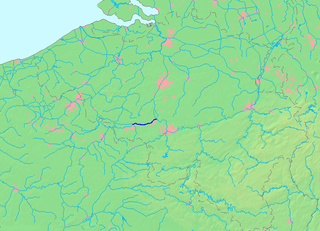
The Canal du Centre is a canal in Wallonia, Belgium, which, with other canals, links the waterways of the Meuse and Scheldt rivers. It has a total length of 20.9 km. It connects the artificial lake Grand Large near Nimy, with the Brussels–Charleroi Canal near Seneffe.

The lifts on the Canal du Centre are a series of four hydraulic boat lifts near the town of La Louvière in Belgium which are classified as a World Heritage Site by UNESCO. All four are located on the Canal du Centre in Belgium's historic sillon industriel industrial belt.

Lake Biwa Canal is a historic waterway in Japan connecting Lake Biwa to the nearby City of Kyoto. Constructed during the Meiji Period the canal was originally designed for the transportation of lake water for drinking, irrigation and industrial purposes, but also provided for the conveyance of waterborne freight and passenger traffic. From 1895 water from the canal supported Japan's first hydroelectric power facility, providing electricity for industry, street lighting and Kyoto's tram system. In 1996 the canal was recognized as a nationally designated Historic Site.

The Saint-Louis-Arzviller inclined plane is an inclined plane on the Marne-Rhine Canal that enables the canal to cross the Vosges Mountains. It is located in the commune of Saint-Louis, between the towns of Saint-Louis and Arzviller in the département of the Moselle.
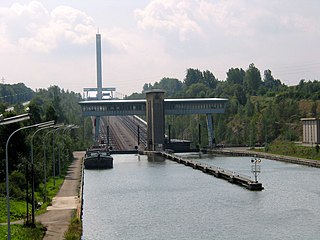
The Ronquières Inclined Plane is a canal inclined plane on the Brussels-Charleroi Canal in the province of Hainaut in Wallonia, Belgium. It opened in April 1968 having taken six years to build. It is in the municipality of Braine-le-Comte and takes its name from the nearby village of Ronquières.

The Shropshire Canal was a tub boat canal built to supply coal, ore and limestone to the industrial region of east Shropshire, England, that adjoined the River Severn at Coalbrookdale. It ran from a junction with the Donnington Wood Canal ascending the 316 yard long Wrockwardine Wood inclined plane to its summit level, it made a junction with the older Ketley Canal and at Southall Bank the Coalbrookdale (Horsehay) branch went to Brierly Hill above Coalbrookdale; the main line descended via the 600 yard long Windmill Incline and the 350 yard long Hay Inclined Plane to Coalport on the River Severn. The short section of the Shropshire Canal from the base of the Hay Inclined Plane to its junction with the River Severn is sometimes referred to as the Coalport Canal.

A tub boat was a type of unpowered cargo boat used on a number of the early English and German canals. The English boats were typically 6 m (19.7 ft) long and 2 m (6.6 ft) wide and generally carried 3 long tons to 5 long tons of cargo, though some extra deep ones could carry up to 8 long tons. They are also called compartment boats or container boats.

The Brussels–Charleroi Canal, also known as the Charleroi Canal amongst other similar names, is an important canal in Belgium. The canal is quite large, with a Class IV Freycinet gauge, and its Walloon portion is 47.9 kilometres (29.8 mi) long. It runs from Charleroi (Wallonia) in the south to Brussels in the north.
James Green (1781–1849) was a noted civil engineer and canal engineer, who was particularly active in the South West of England, where he pioneered the building of tub boat canals, and inventive solutions for coping with hilly terrain, which included tub boat lifts and inclined planes. Although dismissed from two schemes within days of each other, as a result of construction problems, his contribution as a civil engineer was great.